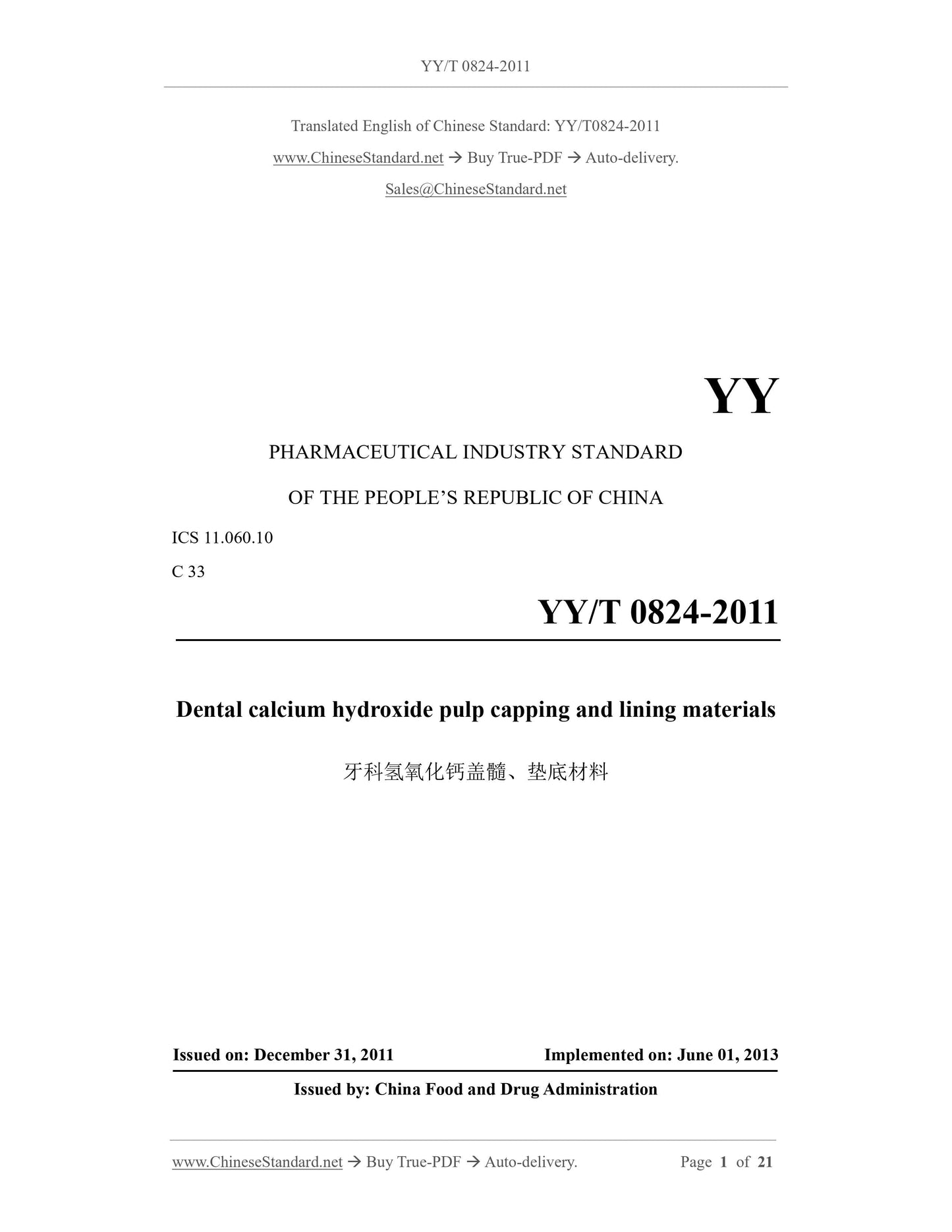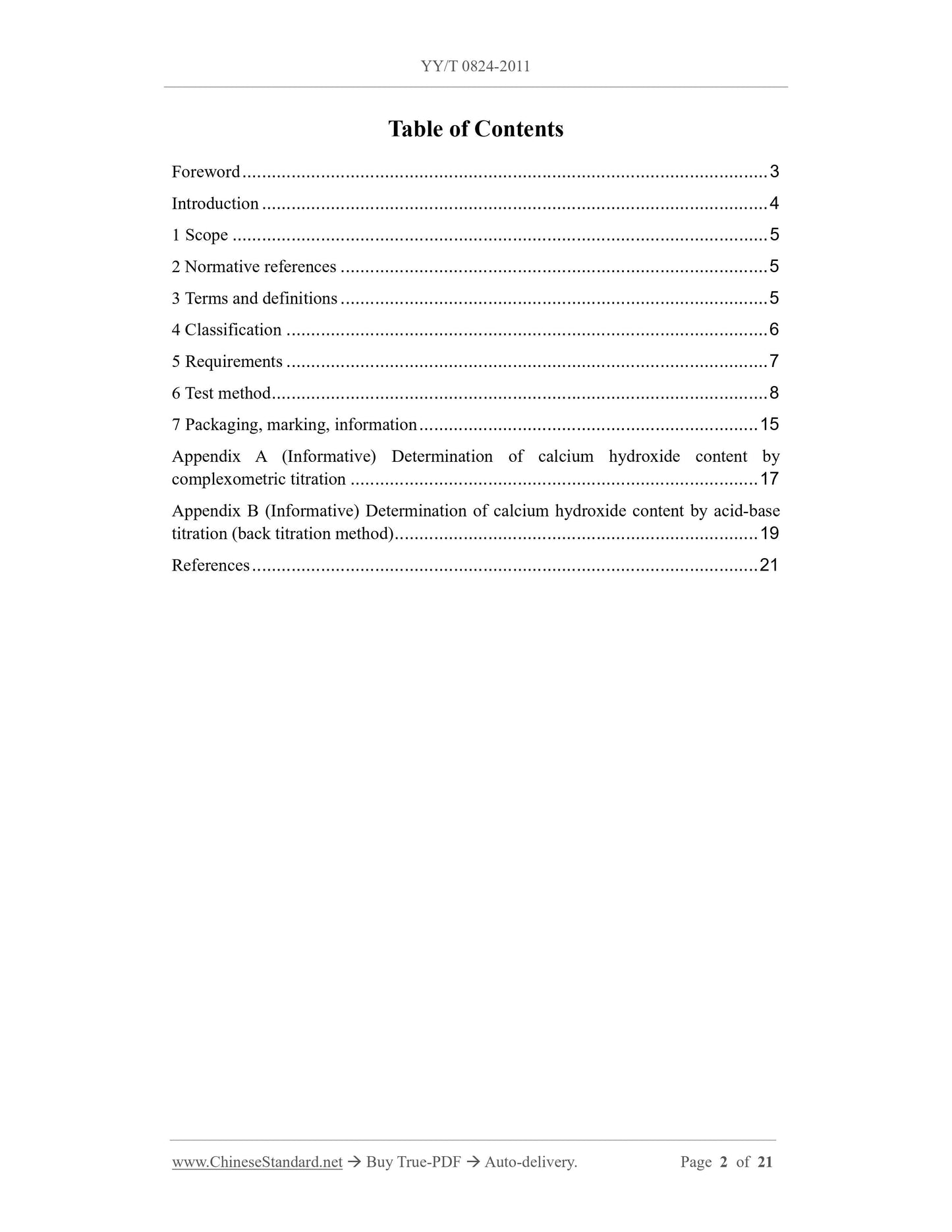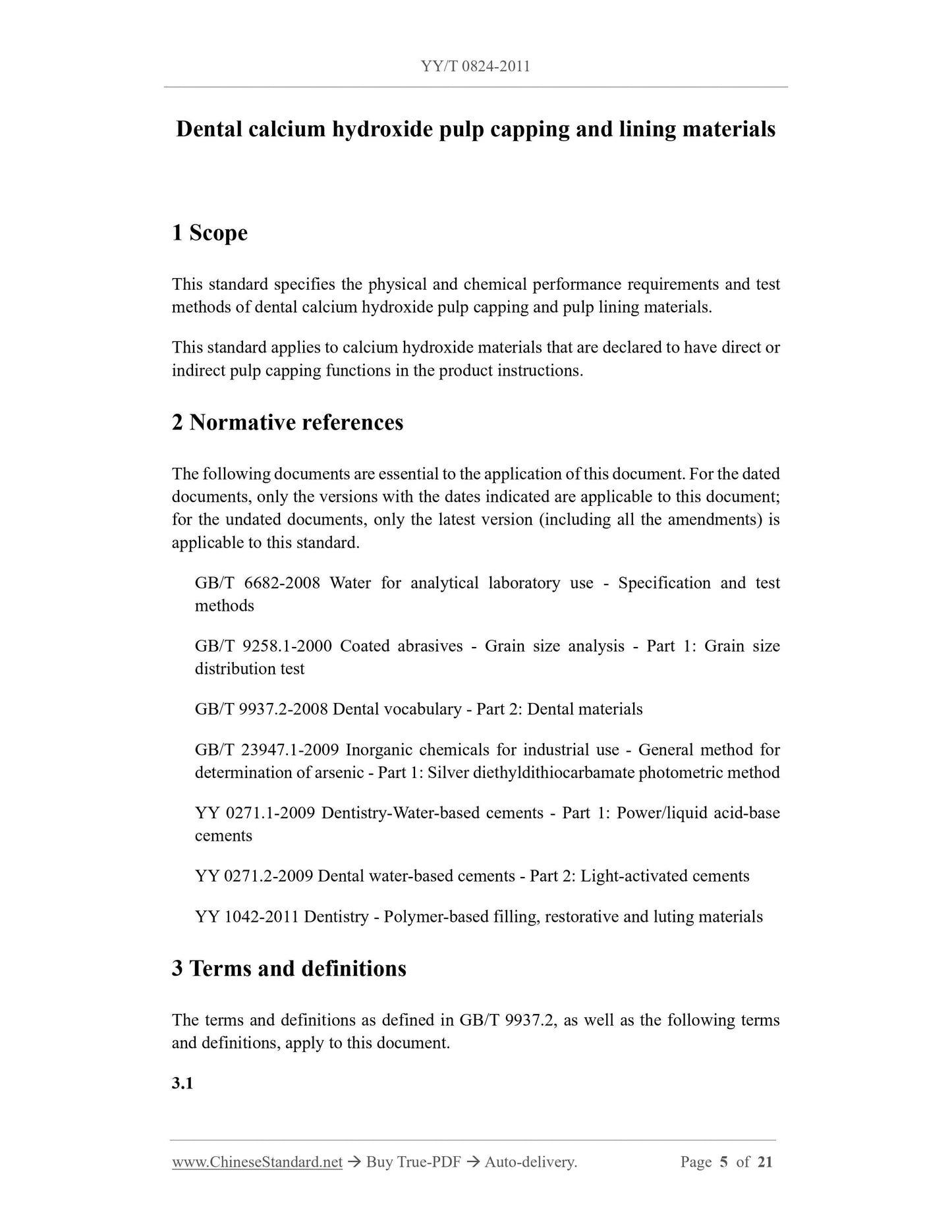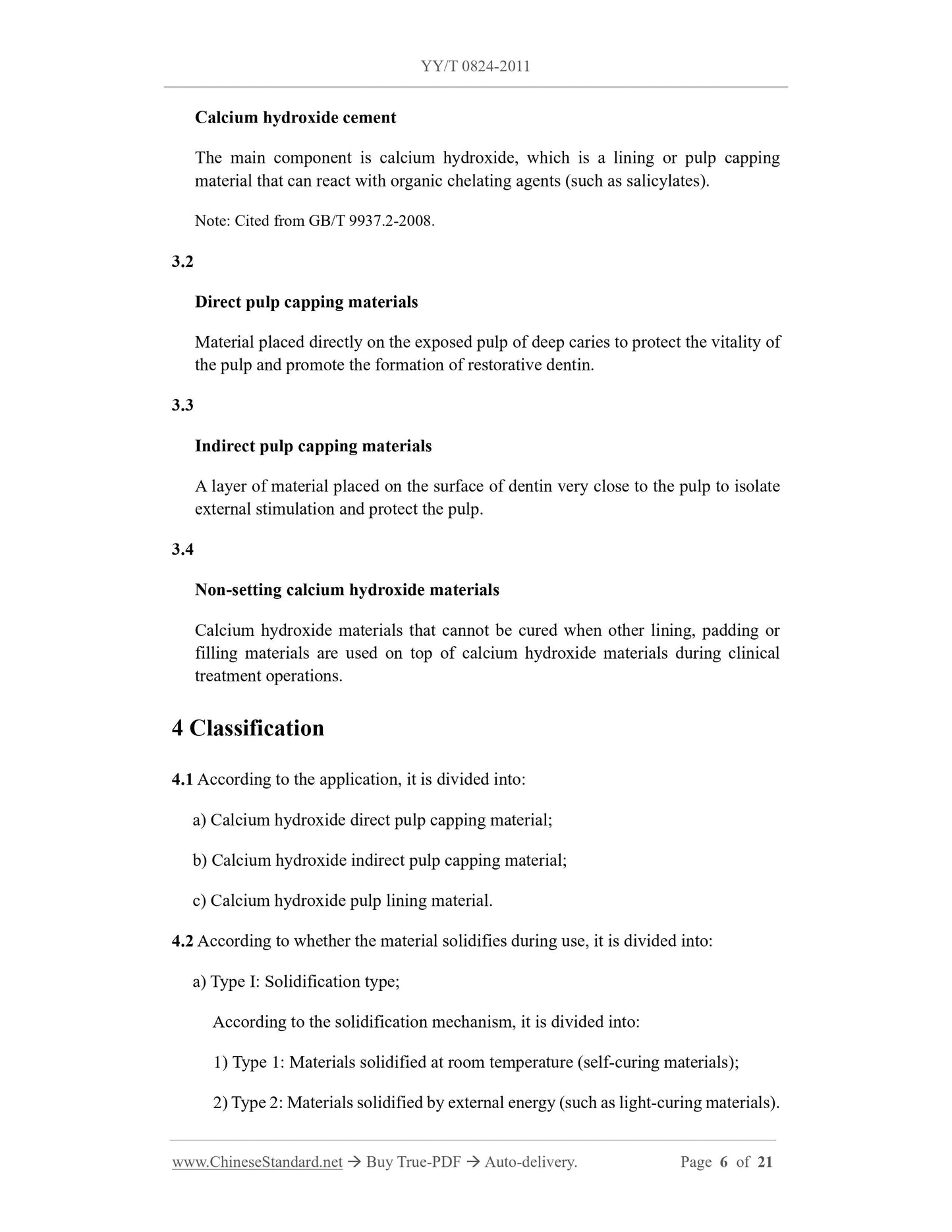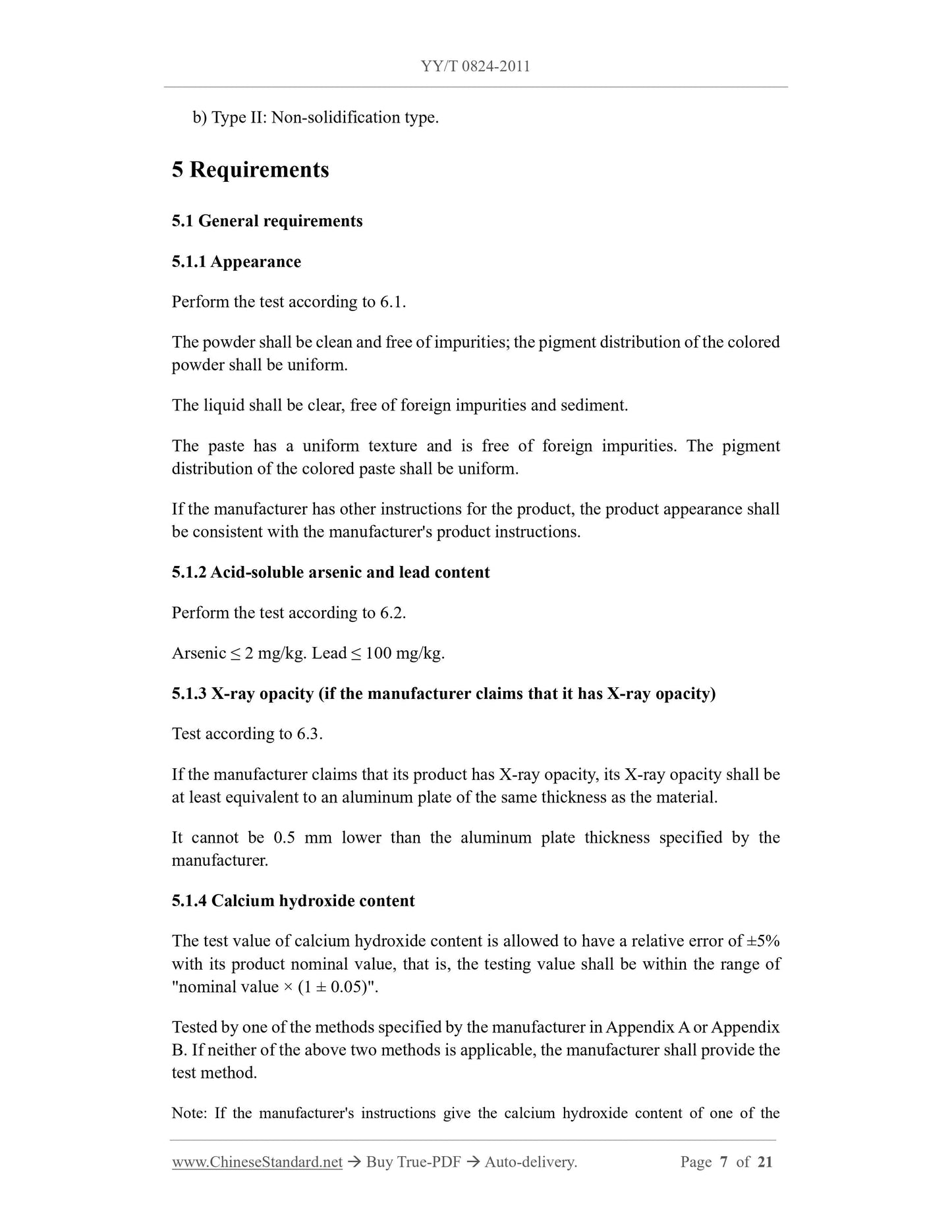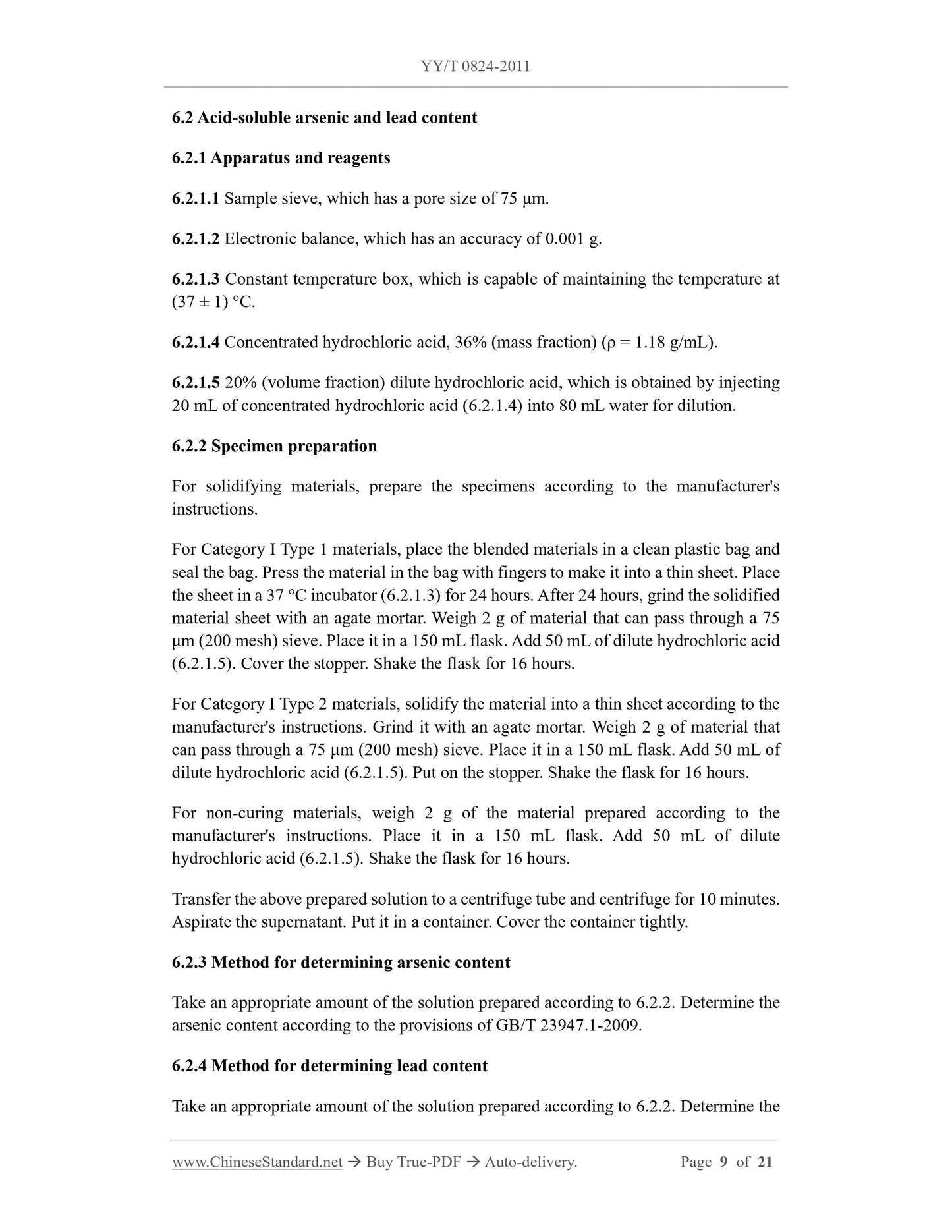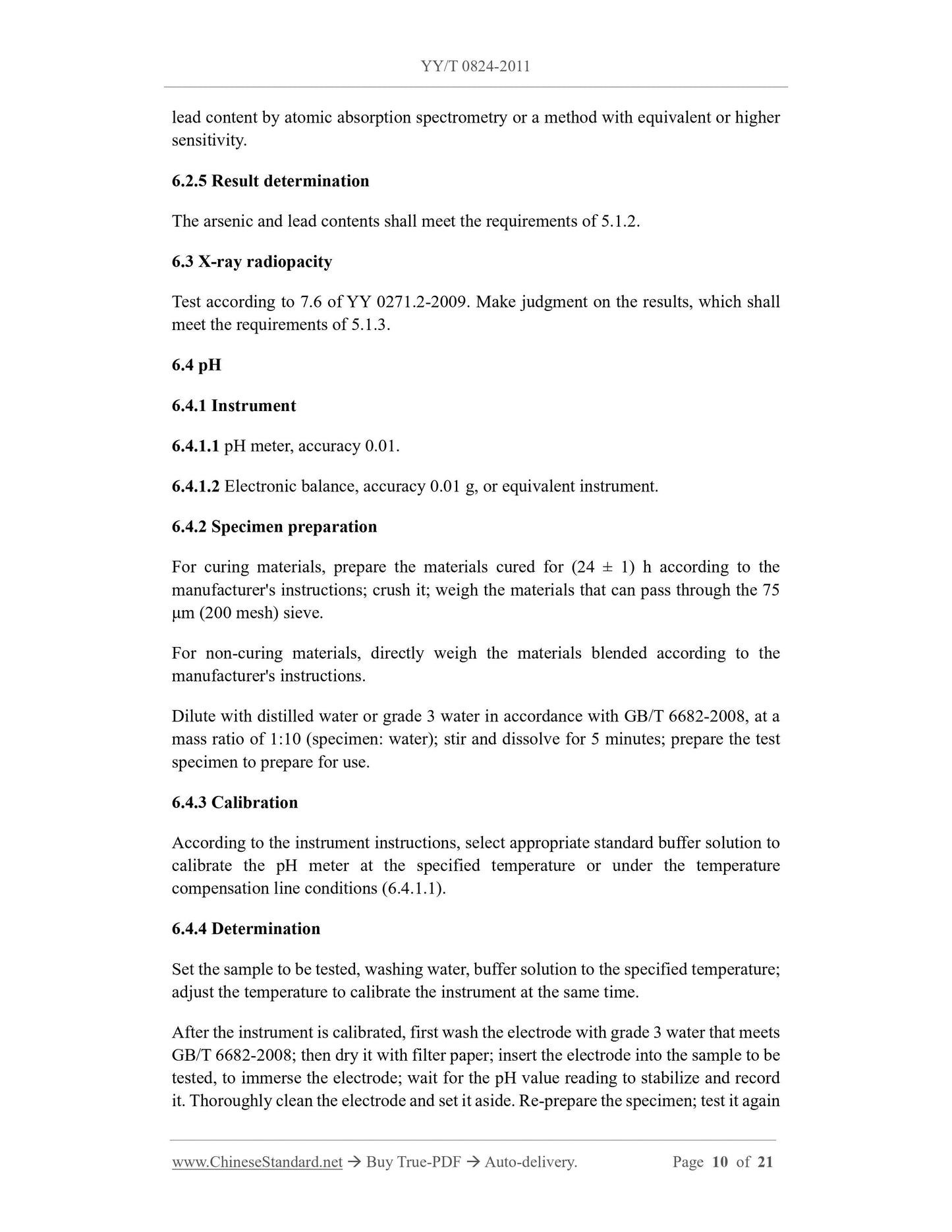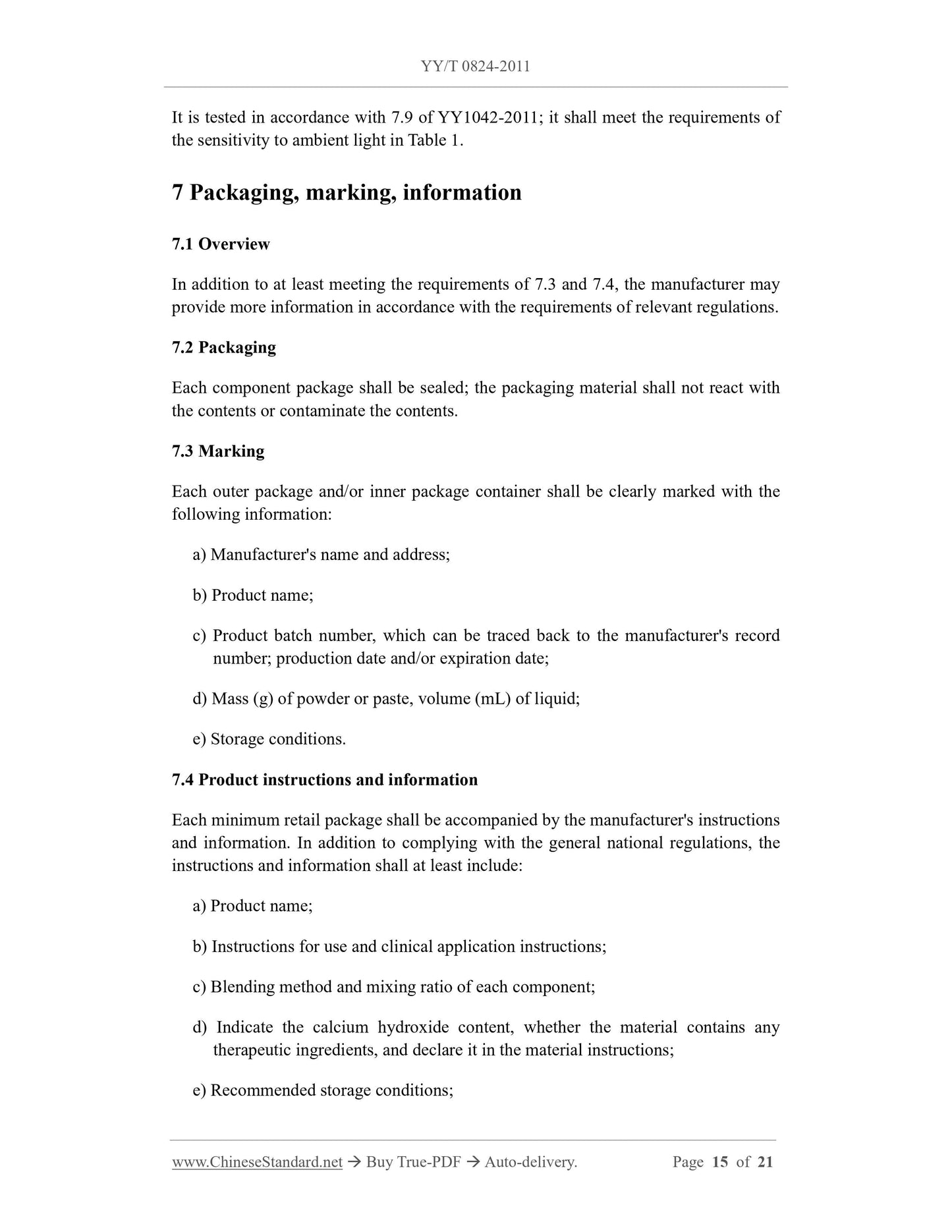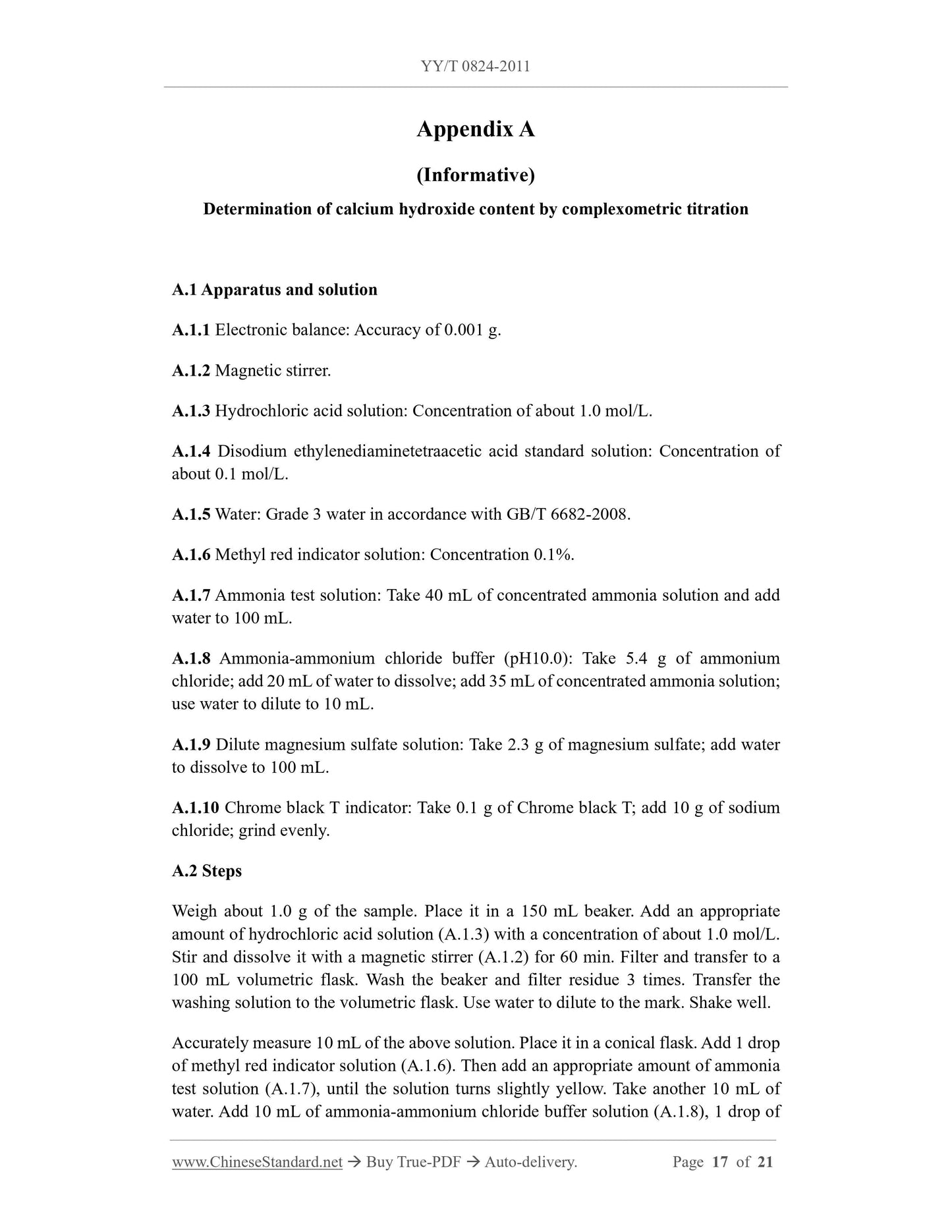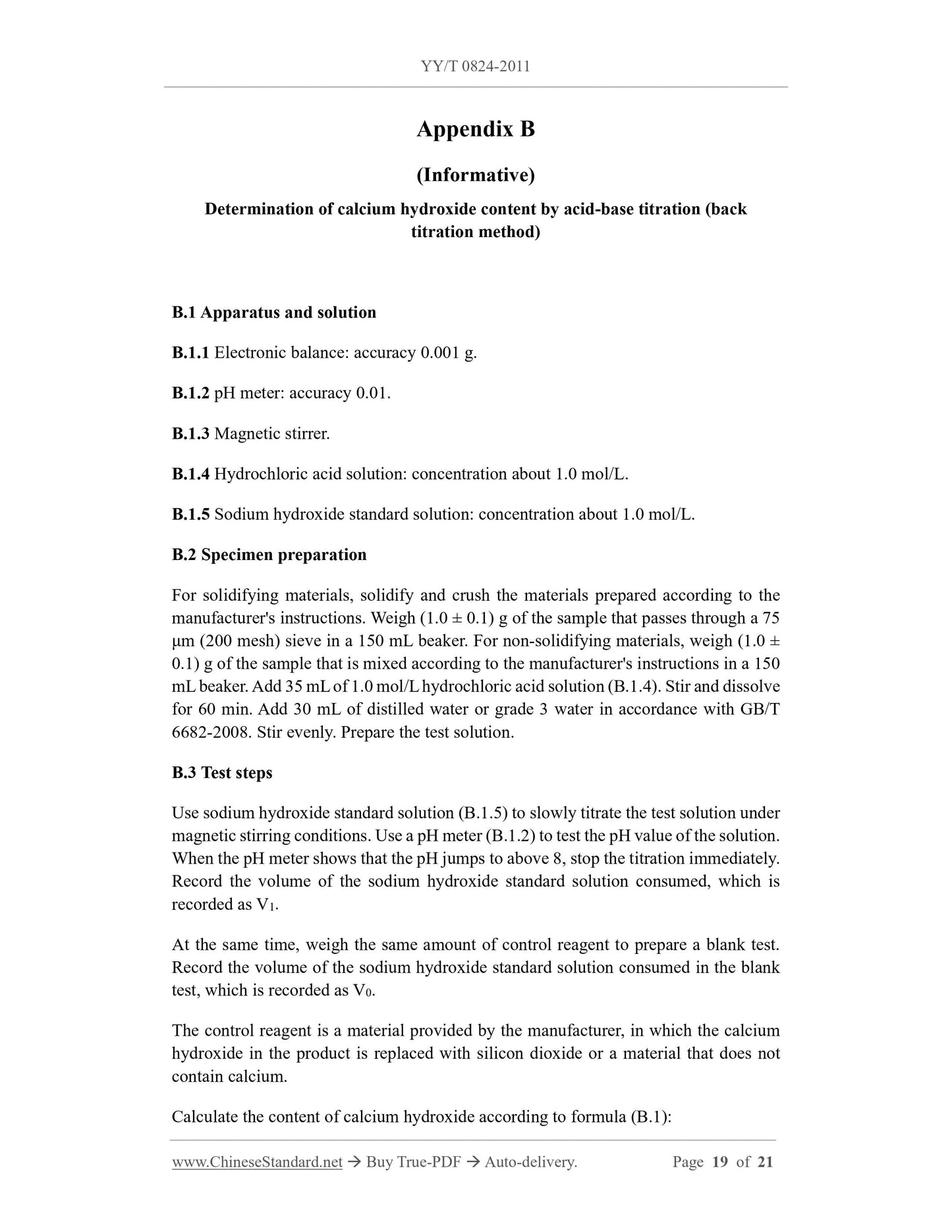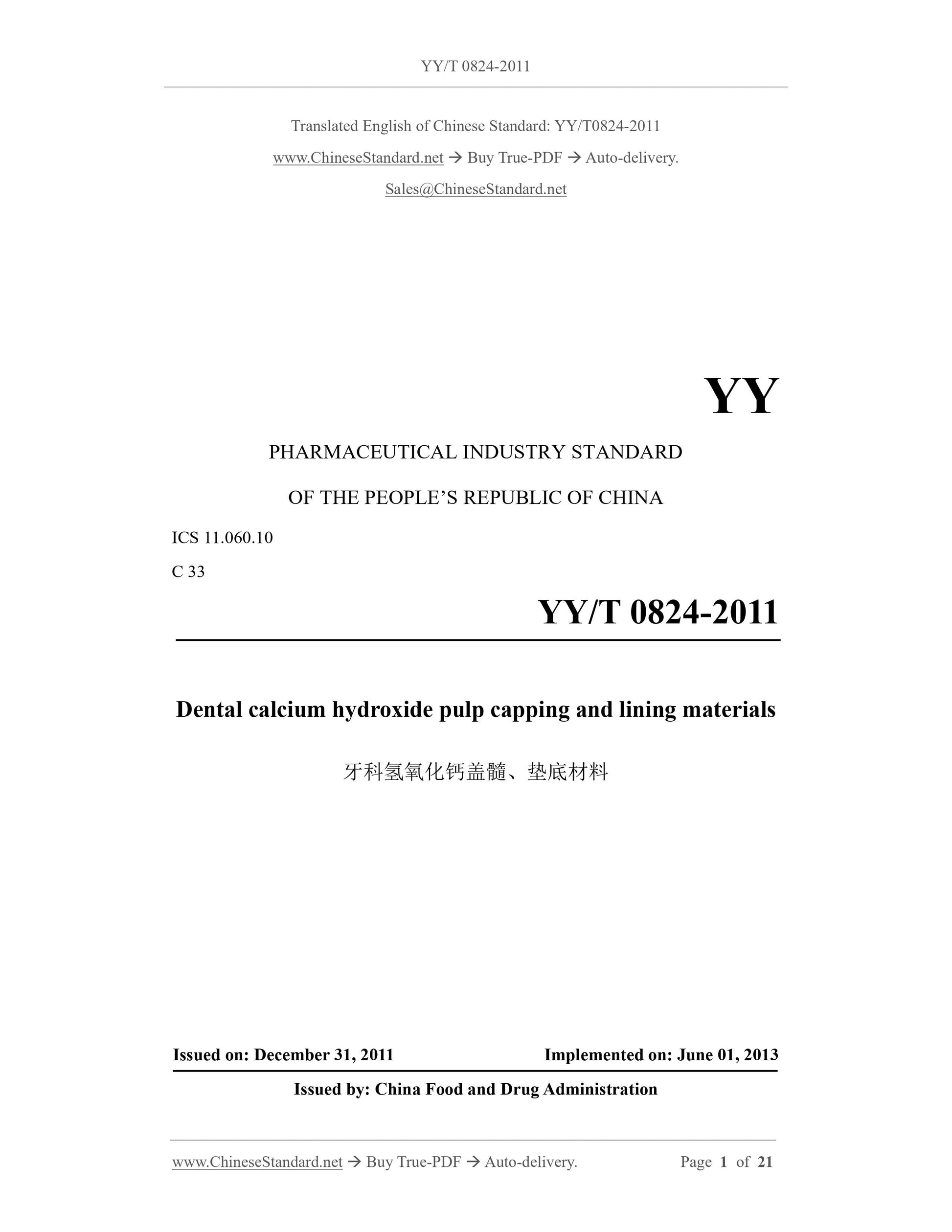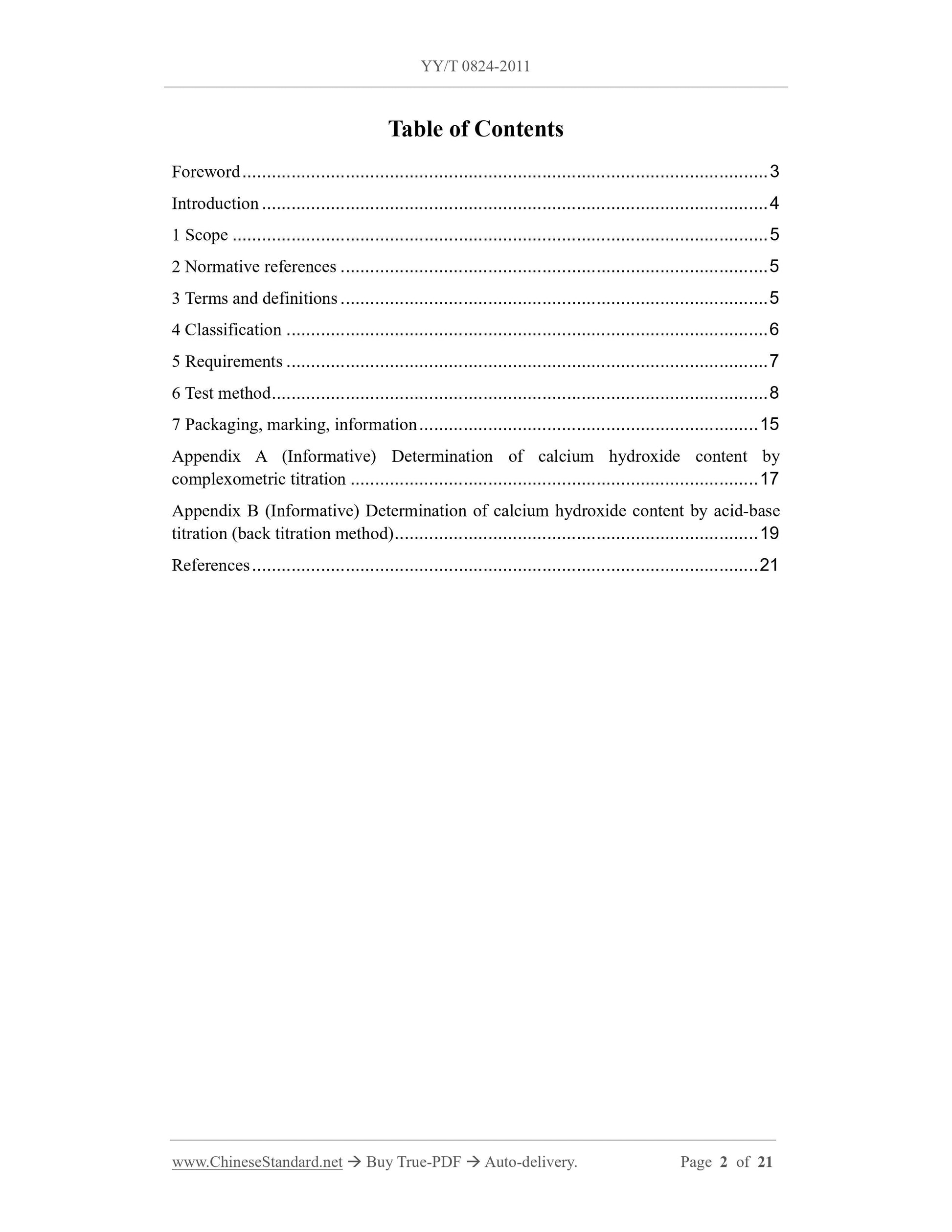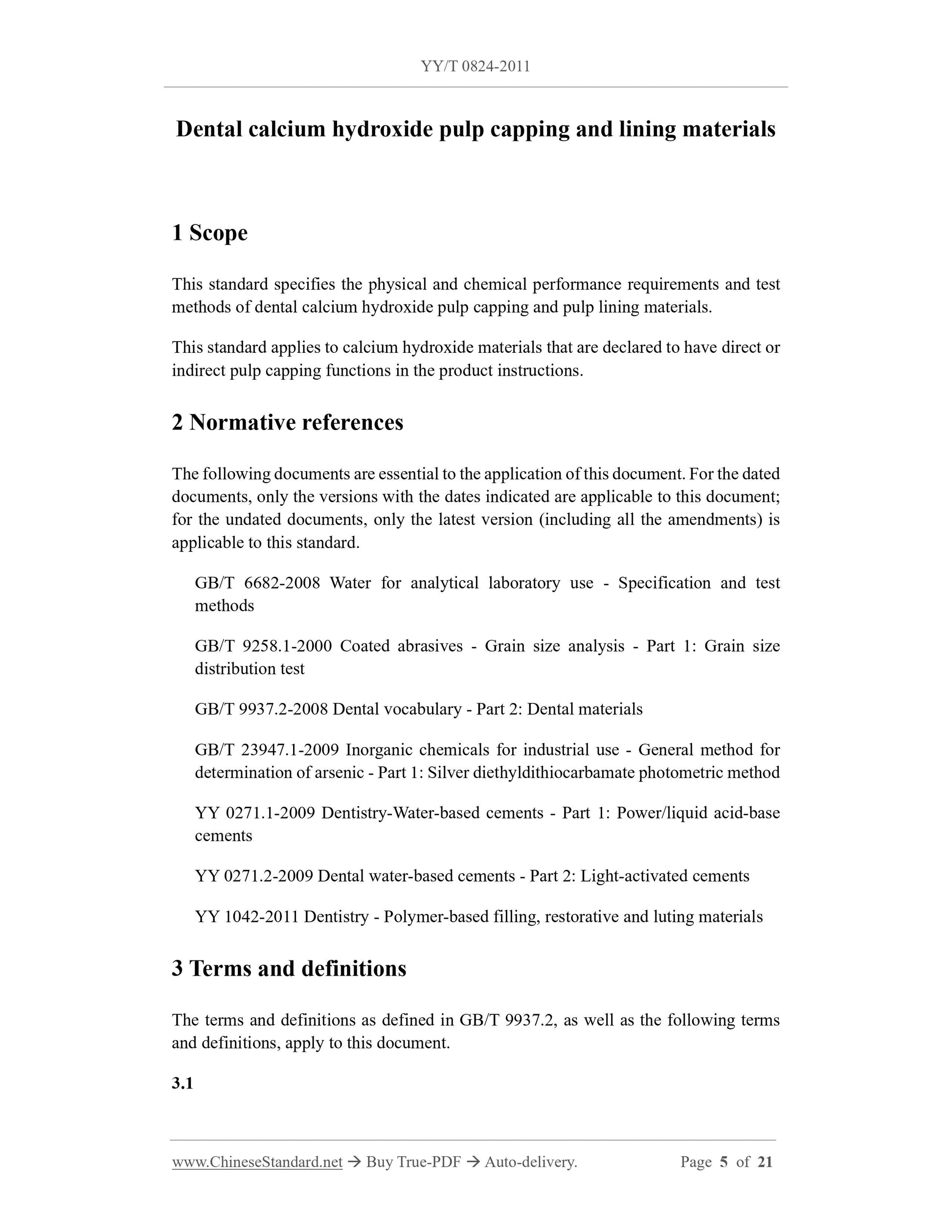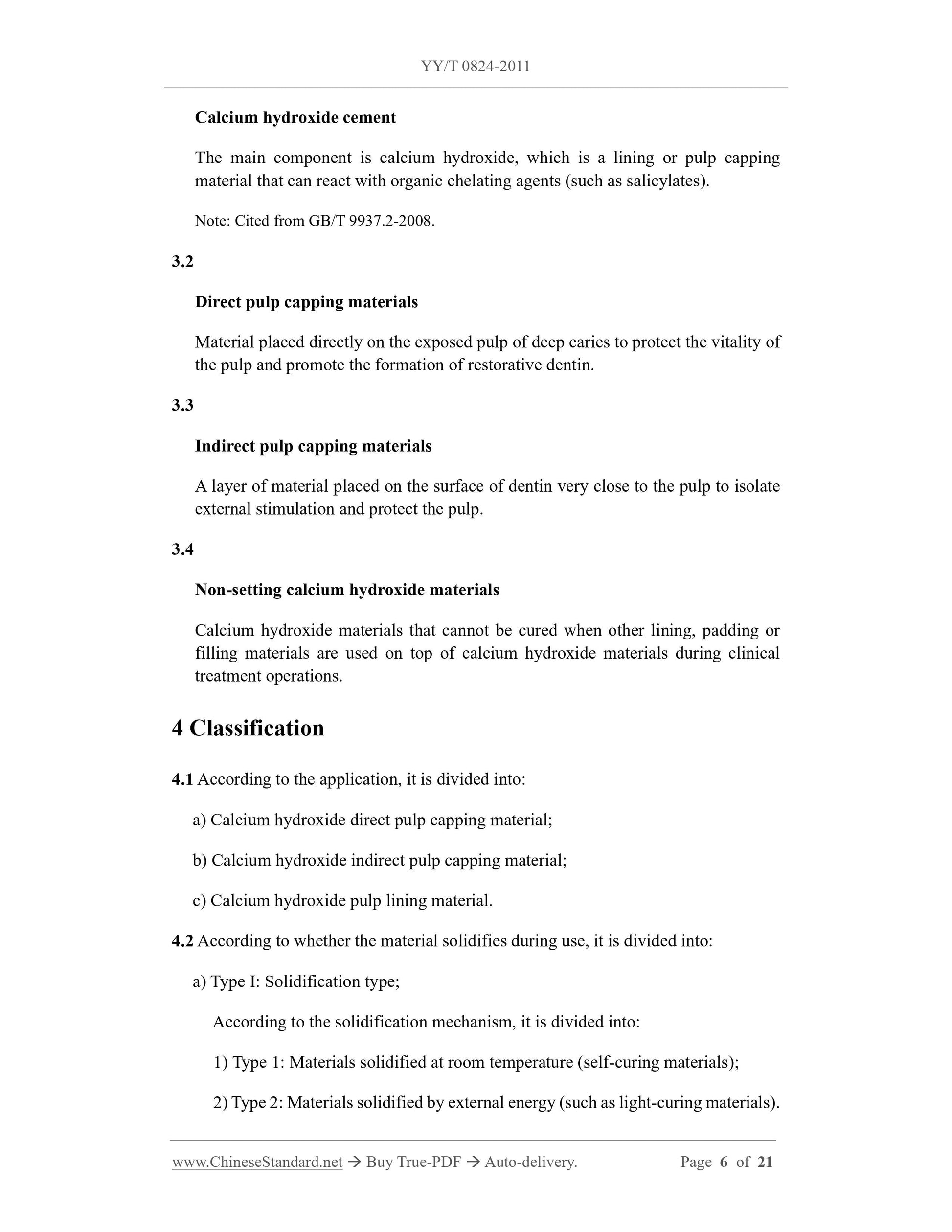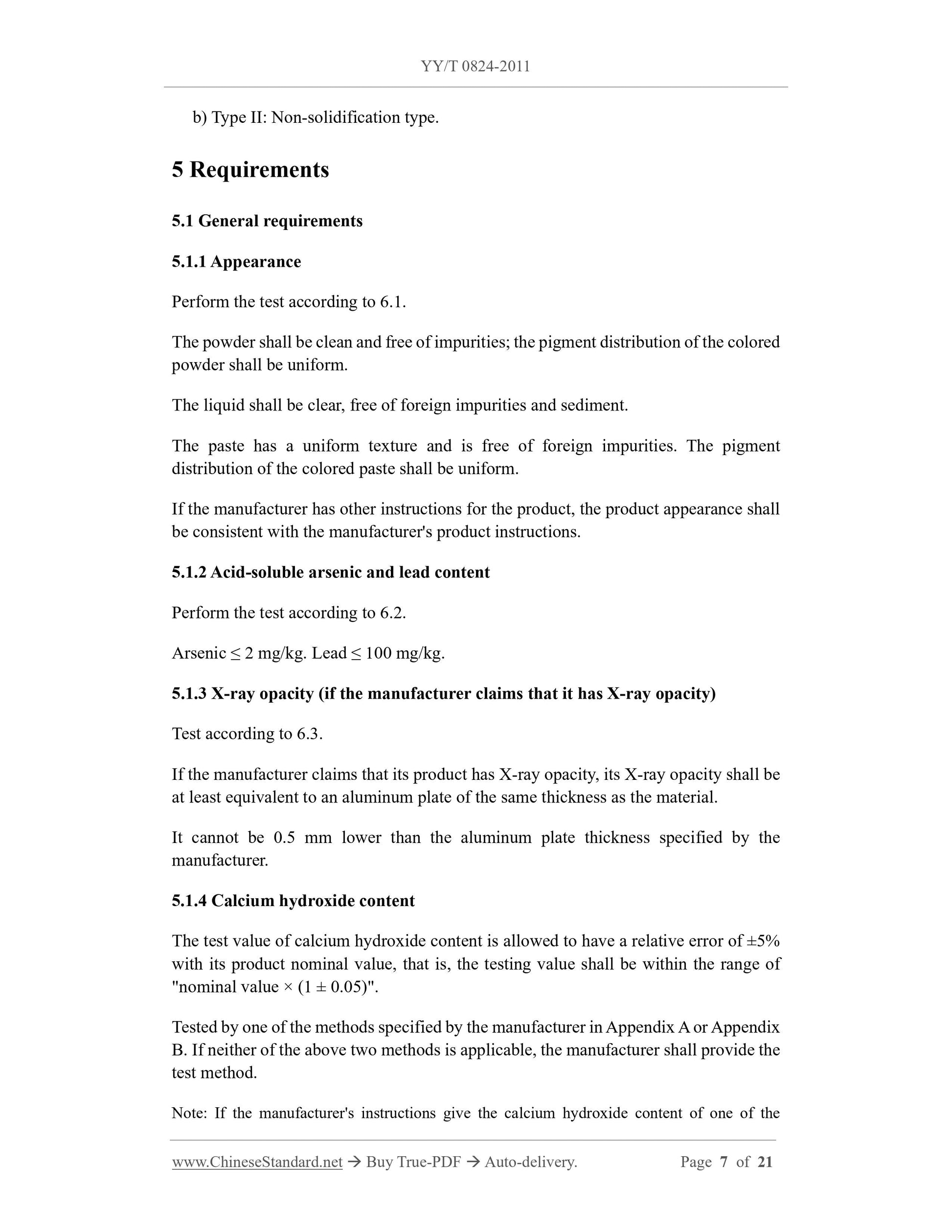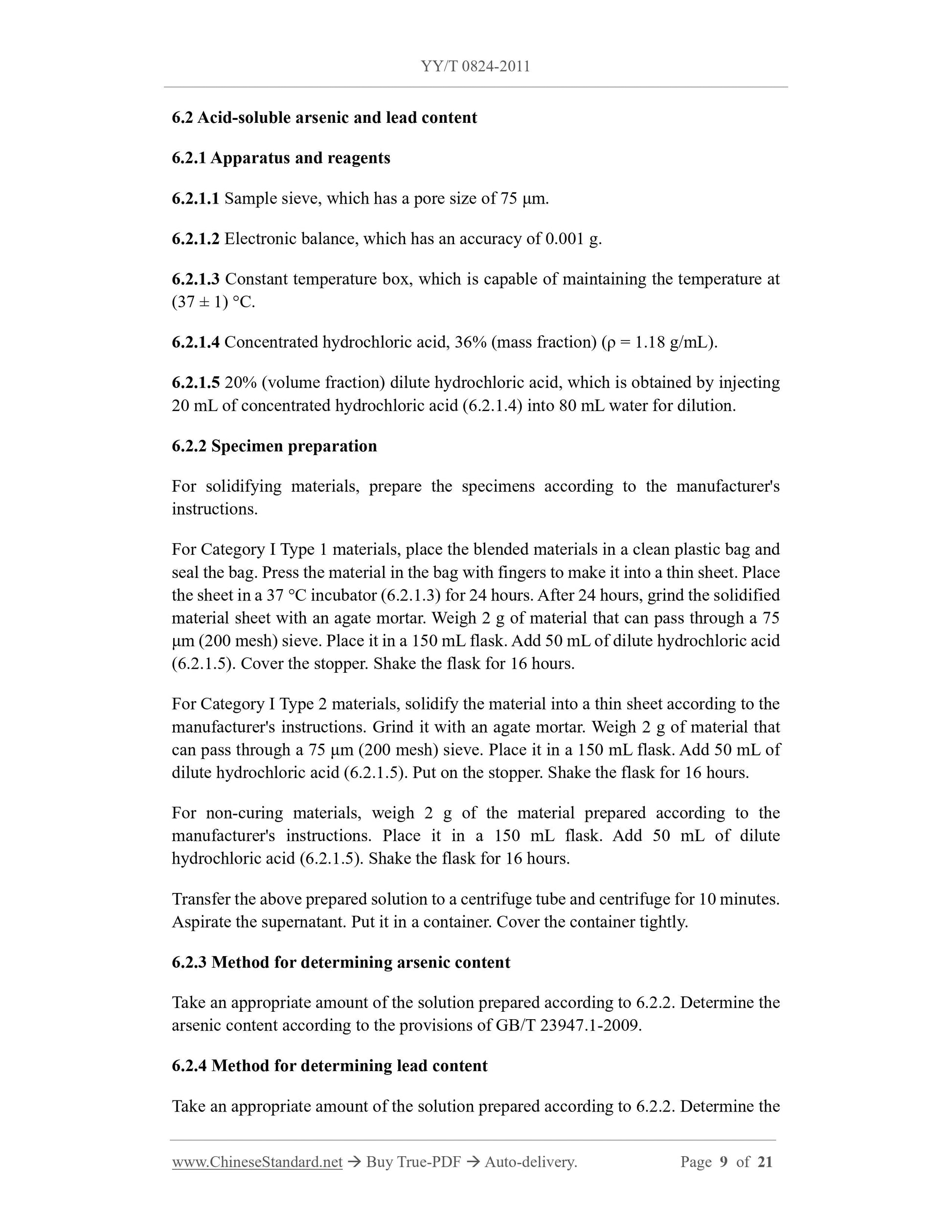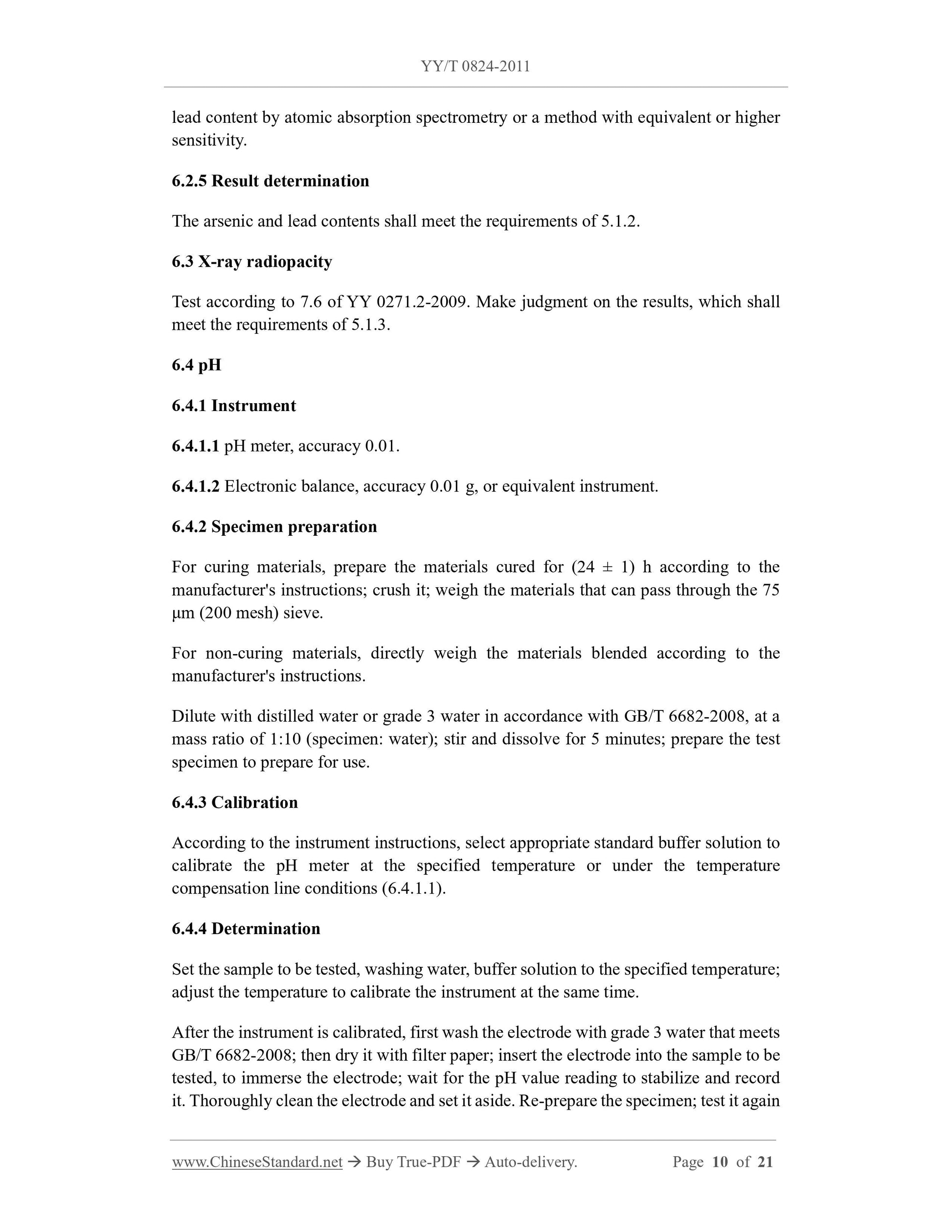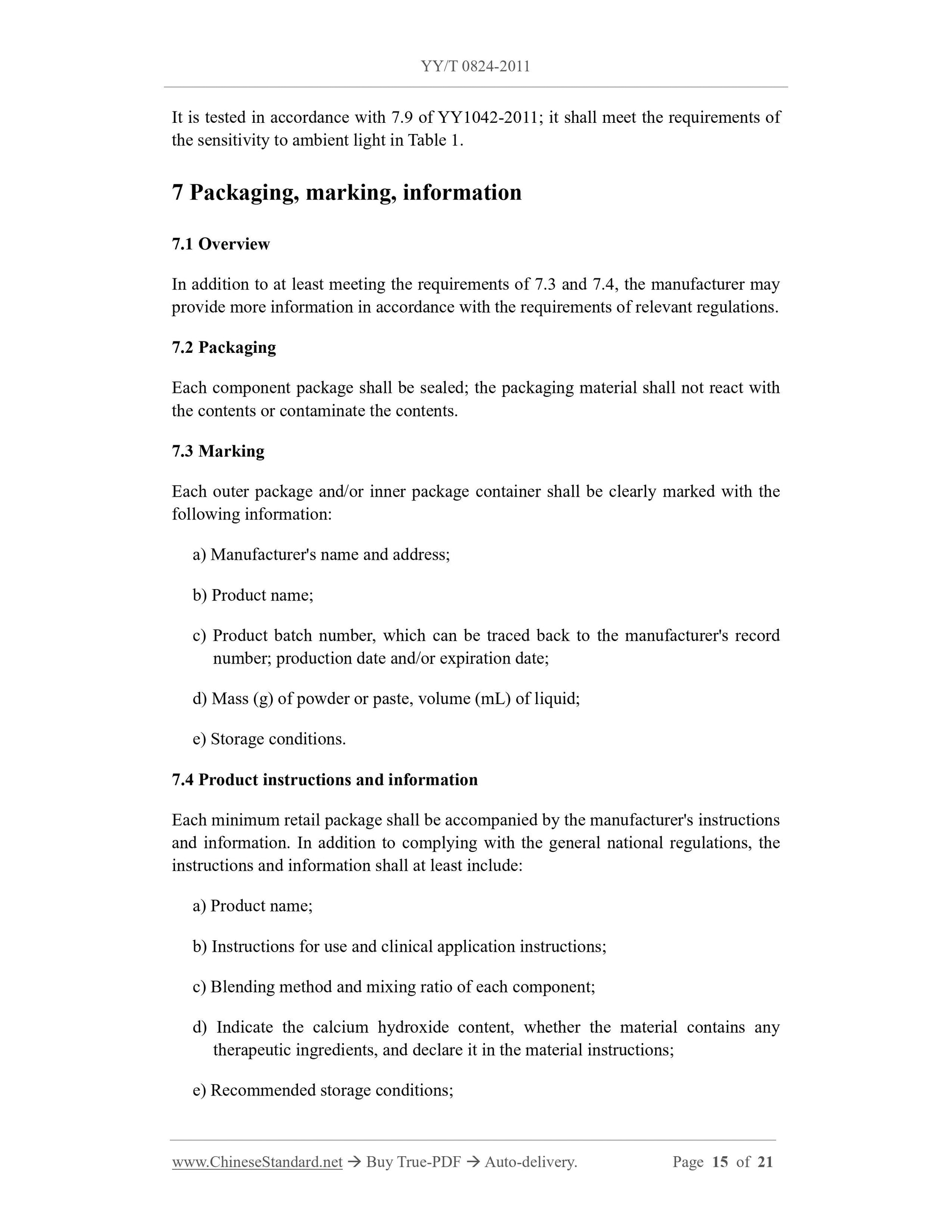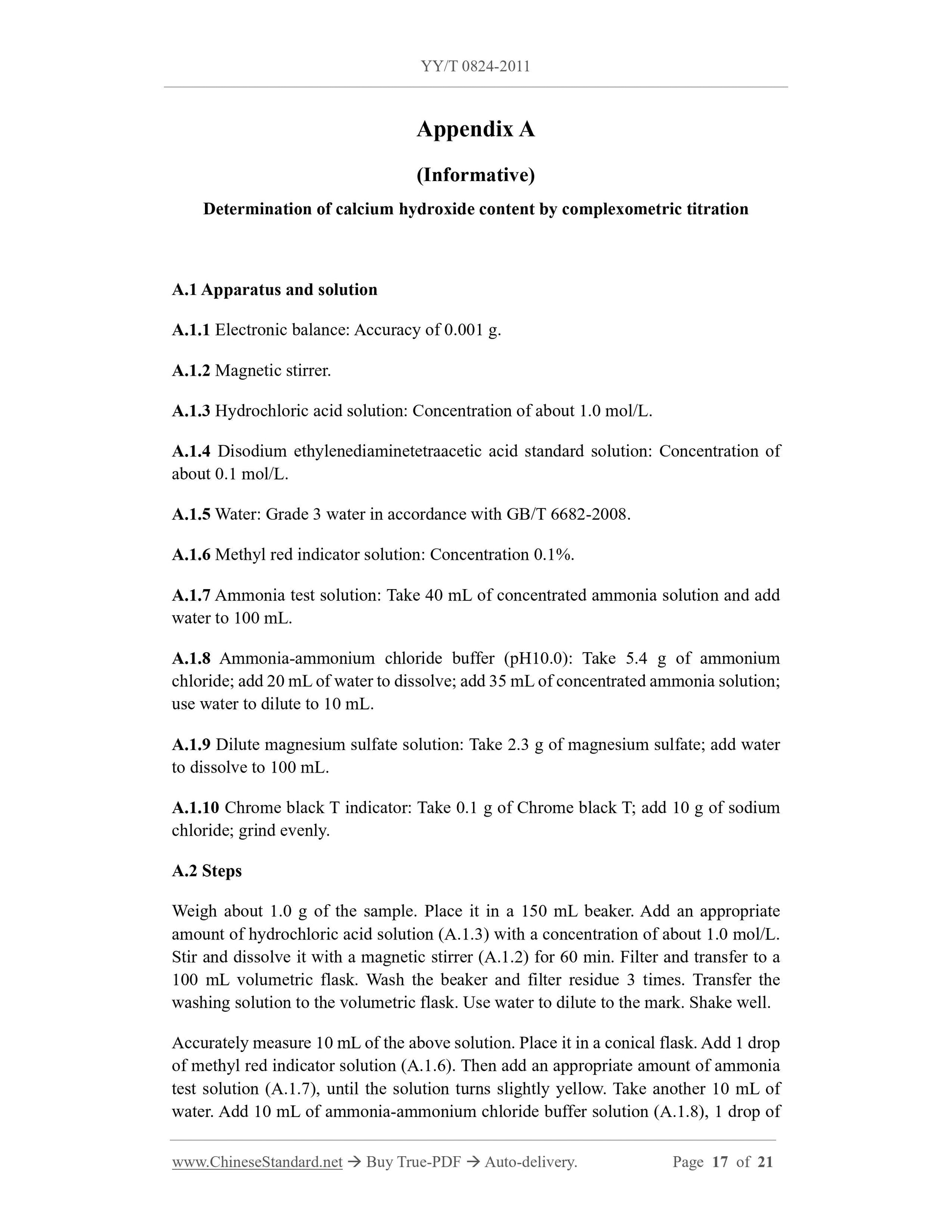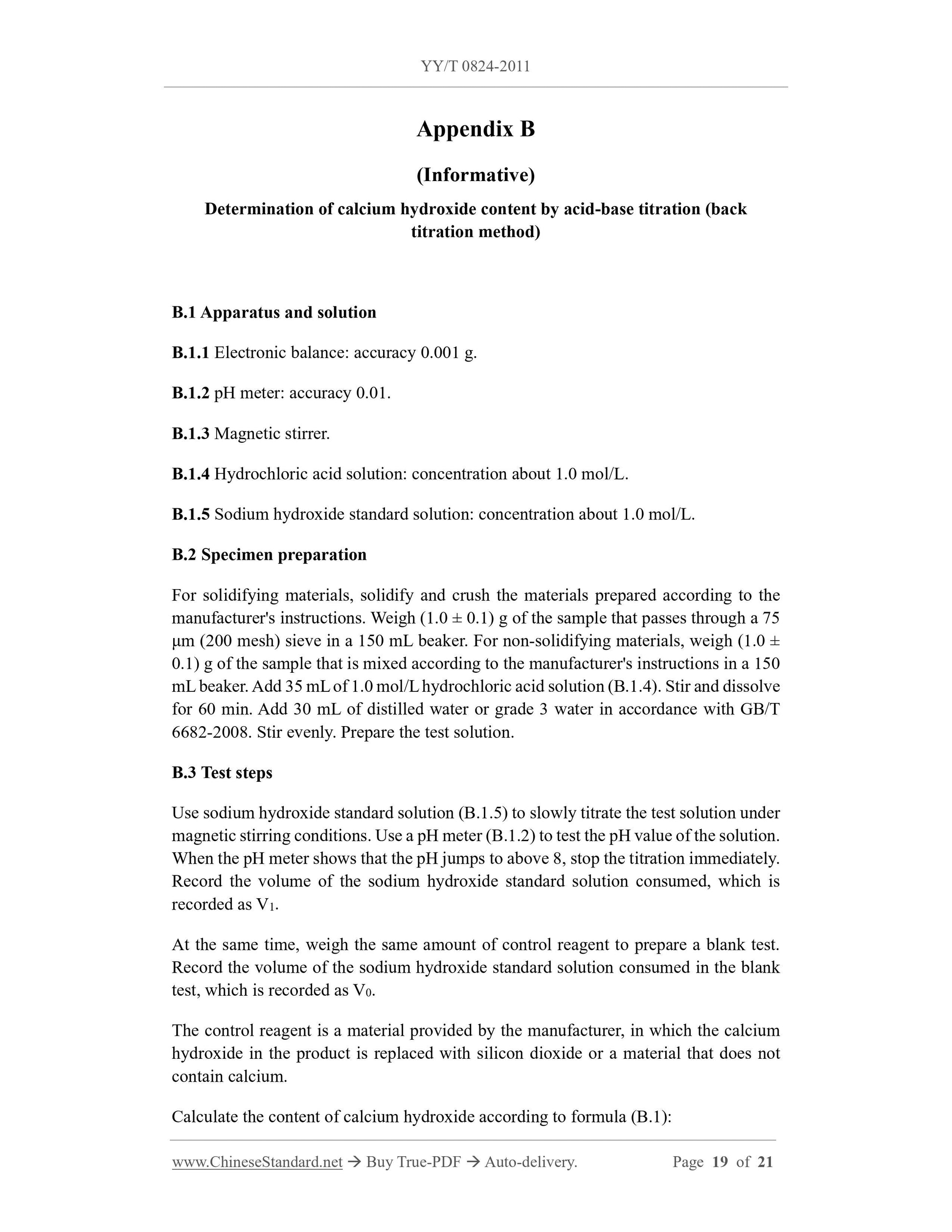1
/
of
10
PayPal, credit cards. Download editable-PDF and invoice in 1 second!
YY/T 0824-2011 English PDF (YYT0824-2011)
YY/T 0824-2011 English PDF (YYT0824-2011)
Regular price
$220.00 USD
Regular price
Sale price
$220.00 USD
Unit price
/
per
Shipping calculated at checkout.
Couldn't load pickup availability
Delivery: 3 seconds. Download true-PDF + Invoice.
Get QUOTATION in 1-minute: Click YY/T 0824-2011
Historical versions: YY/T 0824-2011
Preview True-PDF (Reload/Scroll if blank)
YY/T 0824-2011: Dental calcium hydroxide pulp capping and lining materials
YY/T 0824-2011
YY
PHARMACEUTICAL INDUSTRY STANDARD
OF THE PEOPLE’S REPUBLIC OF CHINA
ICS 11.060.10
C 33
Dental calcium hydroxide pulp capping and lining materials
牙科氢氧化钙盖髓, 垫底材料
ISSUED ON: DECEMBER 31, 2011
IMPLEMENTED ON: JUNE 01, 2013
Issued by: China Food and Drug Administration
Table of Contents
Foreword ... 3
Introduction ... 4
1 Scope ... 5
2 Normative references ... 5
3 Terms and definitions ... 5
4 Classification ... 6
5 Requirements ... 7
6 Test method ... 8
7 Packaging, marking, information ... 15
Appendix A (Informative) Determination of calcium hydroxide content by
complexometric titration ... 17
Appendix B (Informative) Determination of calcium hydroxide content by acid-base
titration (back titration method) ... 19
References ... 21
Dental calcium hydroxide pulp capping and lining materials
1 Scope
This standard specifies the physical and chemical performance requirements and test
methods of dental calcium hydroxide pulp capping and pulp lining materials.
This standard applies to calcium hydroxide materials that are declared to have direct or
indirect pulp capping functions in the product instructions.
2 Normative references
The following documents are essential to the application of this document. For the dated
documents, only the versions with the dates indicated are applicable to this document;
for the undated documents, only the latest version (including all the amendments) is
applicable to this standard.
GB/T 6682-2008 Water for analytical laboratory use - Specification and test
methods
GB/T 9258.1-2000 Coated abrasives - Grain size analysis - Part 1: Grain size
distribution test
GB/T 9937.2-2008 Dental vocabulary - Part 2: Dental materials
GB/T 23947.1-2009 Inorganic chemicals for industrial use - General method for
determination of arsenic - Part 1: Silver diethyldithiocarbamate photometric method
YY 0271.1-2009 Dentistry-Water-based cements - Part 1: Power/liquid acid-base
cements
YY 0271.2-2009 Dental water-based cements - Part 2: Light-activated cements
YY 1042-2011 Dentistry - Polymer-based filling, restorative and luting materials
3 Terms and definitions
The terms and definitions as defined in GB/T 9937.2, as well as the following terms
and definitions, apply to this document.
3.1
Calcium hydroxide cement
The main component is calcium hydroxide, which is a lining or pulp capping
material that can react with organic chelating agents (such as salicylates).
Note: Cited from GB/T 9937.2-2008.
3.2
Direct pulp capping materials
Material placed directly on the exposed pulp of deep caries to protect the vitality of
the pulp and promote the formation of restorative dentin.
3.3
Indirect pulp capping materials
A layer of material placed on the surface of dentin very close to the pulp to isolate
external stimulation and protect the pulp.
3.4
Non-setting calcium hydroxide materials
Calcium hydroxide materials that cannot be cured when other lining, padding or
filling materials are used on top of calcium hydroxide materials during clinical
treatment operations.
4 Classification
4.1 According to the application, it is divided into:
a) Calcium hydroxide direct pulp capping material;
b) Calcium hydroxide indirect pulp capping material;
c) Calcium hydroxide pulp lining material.
4.2 According to whether the material solidifies during use, it is divided into:
a) Type I: Solidification type;
According to the solidification mechanism, it is divided into:
1) Type 1: Materials solidified at room temperature (self-curing materials);
2) Type 2: Materials solidified by external energy (such as light-curing materials).
b) Type II: Non-solidification type.
5 Requirements
5.1 General requirements
5.1.1 Appearance
Perform the test according to 6.1.
The powder shall be clean and free of impurities; the pigment distribution of the colored
powder shall be uniform.
The liquid shall be clear, free of foreign impurities and sediment.
The paste has a uniform texture and is free of foreign impurities. The pigment
distribution of the colored paste shall be uniform.
If the manufacturer has other instructions for the product, the product appearance shall
be consistent with the manufacturer's product instructions.
5.1.2 Acid-soluble arsenic and lead content
Perform the test according to 6.2.
Arsenic ≤ 2 mg/kg. Lead ≤ 100 mg/kg.
5.1.3 X-ray opacity (if the manufacturer claims that it has X-ray opacity)
Test according to 6.3.
If the manufacturer claims that its product has X-ray opacity, its X-ray opacity shall be
at least equivalent to an aluminum plate of the same thickness as the material.
It cannot be 0.5 mm lower than the aluminum plate thickness specified by the
manufacturer.
5.1.4 Calcium hydroxide content
The test value of calcium hydroxide content is allowed to have a relative error of ±5%
with its product nominal value, that is, the testing value shall be within the range of
"nominal value × (1 ± 0.05)".
Tested by one of the methods specified by the manufacturer in Appendix A or Appendix
B. If neither of the above two methods is applicable, the manufacturer shall provide the
test method.
Note: If the manufacturer's instructions give the calcium hydroxide content of one of the
6.2 Acid-soluble arsenic and lead content
6.2.1 Apparatus and reagents
6.2.1.1 Sample sieve, which has a pore size of 75 μm.
6.2.1.2 Electronic balance, which has an accuracy of 0.001 g.
6.2.1.3 Constant temperature box, which is capable of maintaining the temperature at
(37 ± 1) °C.
6.2.1.4 Concentrated hydrochloric acid, 36% (mass fraction) (ρ = 1.18 g/mL).
6.2.1.5 20% (volume fraction) dilute hydrochloric acid, which is obtained by injecting
20 mL of concentrated hydrochloric acid (6.2.1.4) into 80 mL water for dilution.
6.2.2 Specimen preparation
For solidifying materials, prepare the specimens according to the manufacturer's
instructions.
For Category I Type 1 materials, place the blended materials in a clean plastic bag and
seal the bag. Press the material in the bag with fingers to make it into a thin sheet. Place
the sheet in a 37 °C incubator (6.2.1.3) for 24 hours. After 24 hours, grind the solidified
material sheet with an agate mortar. Weigh 2 g of material that can pass through a 75
μm (200 mesh) sieve. Place it in a 150 mL flask. Add 50 mL of dilute hydrochloric acid
(6.2.1.5). Cover the stopper. Shake the flask for 16 hours.
For Category I Type 2 materials, solidify the material into a thin sheet according to the
manufacturer's instructions. Grind it with an agate mortar. Weigh 2 g of material that
can pass through a 75 μm (200 mesh) sieve. Place it in a 150 mL flask. Add 50 mL of
dilute hydrochloric acid (6.2.1.5). Put on the stopper. Shake the flask for 16 hours.
For non-curing materials, weigh 2 g of the material prepared according to the
manufacturer's instructions. Place it in a 150 mL flask. Add 50 mL of dilute
hydrochloric acid (6.2.1.5). Shake the flask for 16 hours.
Transfer the above prepared solution to a centrifuge tube and centrifuge for 10 minutes.
Aspirate the supernatant. Put it in a container. Cover the container tightly.
6.2.3 Method for determining arsenic content
Take an appropriate amount of the solution prepared according to 6.2.2. Determine the
arsenic content according to the provisions of GB/T 23947.1-2009.
6.2.4 Method for determining lead content
Take an appropri...
Get QUOTATION in 1-minute: Click YY/T 0824-2011
Historical versions: YY/T 0824-2011
Preview True-PDF (Reload/Scroll if blank)
YY/T 0824-2011: Dental calcium hydroxide pulp capping and lining materials
YY/T 0824-2011
YY
PHARMACEUTICAL INDUSTRY STANDARD
OF THE PEOPLE’S REPUBLIC OF CHINA
ICS 11.060.10
C 33
Dental calcium hydroxide pulp capping and lining materials
牙科氢氧化钙盖髓, 垫底材料
ISSUED ON: DECEMBER 31, 2011
IMPLEMENTED ON: JUNE 01, 2013
Issued by: China Food and Drug Administration
Table of Contents
Foreword ... 3
Introduction ... 4
1 Scope ... 5
2 Normative references ... 5
3 Terms and definitions ... 5
4 Classification ... 6
5 Requirements ... 7
6 Test method ... 8
7 Packaging, marking, information ... 15
Appendix A (Informative) Determination of calcium hydroxide content by
complexometric titration ... 17
Appendix B (Informative) Determination of calcium hydroxide content by acid-base
titration (back titration method) ... 19
References ... 21
Dental calcium hydroxide pulp capping and lining materials
1 Scope
This standard specifies the physical and chemical performance requirements and test
methods of dental calcium hydroxide pulp capping and pulp lining materials.
This standard applies to calcium hydroxide materials that are declared to have direct or
indirect pulp capping functions in the product instructions.
2 Normative references
The following documents are essential to the application of this document. For the dated
documents, only the versions with the dates indicated are applicable to this document;
for the undated documents, only the latest version (including all the amendments) is
applicable to this standard.
GB/T 6682-2008 Water for analytical laboratory use - Specification and test
methods
GB/T 9258.1-2000 Coated abrasives - Grain size analysis - Part 1: Grain size
distribution test
GB/T 9937.2-2008 Dental vocabulary - Part 2: Dental materials
GB/T 23947.1-2009 Inorganic chemicals for industrial use - General method for
determination of arsenic - Part 1: Silver diethyldithiocarbamate photometric method
YY 0271.1-2009 Dentistry-Water-based cements - Part 1: Power/liquid acid-base
cements
YY 0271.2-2009 Dental water-based cements - Part 2: Light-activated cements
YY 1042-2011 Dentistry - Polymer-based filling, restorative and luting materials
3 Terms and definitions
The terms and definitions as defined in GB/T 9937.2, as well as the following terms
and definitions, apply to this document.
3.1
Calcium hydroxide cement
The main component is calcium hydroxide, which is a lining or pulp capping
material that can react with organic chelating agents (such as salicylates).
Note: Cited from GB/T 9937.2-2008.
3.2
Direct pulp capping materials
Material placed directly on the exposed pulp of deep caries to protect the vitality of
the pulp and promote the formation of restorative dentin.
3.3
Indirect pulp capping materials
A layer of material placed on the surface of dentin very close to the pulp to isolate
external stimulation and protect the pulp.
3.4
Non-setting calcium hydroxide materials
Calcium hydroxide materials that cannot be cured when other lining, padding or
filling materials are used on top of calcium hydroxide materials during clinical
treatment operations.
4 Classification
4.1 According to the application, it is divided into:
a) Calcium hydroxide direct pulp capping material;
b) Calcium hydroxide indirect pulp capping material;
c) Calcium hydroxide pulp lining material.
4.2 According to whether the material solidifies during use, it is divided into:
a) Type I: Solidification type;
According to the solidification mechanism, it is divided into:
1) Type 1: Materials solidified at room temperature (self-curing materials);
2) Type 2: Materials solidified by external energy (such as light-curing materials).
b) Type II: Non-solidification type.
5 Requirements
5.1 General requirements
5.1.1 Appearance
Perform the test according to 6.1.
The powder shall be clean and free of impurities; the pigment distribution of the colored
powder shall be uniform.
The liquid shall be clear, free of foreign impurities and sediment.
The paste has a uniform texture and is free of foreign impurities. The pigment
distribution of the colored paste shall be uniform.
If the manufacturer has other instructions for the product, the product appearance shall
be consistent with the manufacturer's product instructions.
5.1.2 Acid-soluble arsenic and lead content
Perform the test according to 6.2.
Arsenic ≤ 2 mg/kg. Lead ≤ 100 mg/kg.
5.1.3 X-ray opacity (if the manufacturer claims that it has X-ray opacity)
Test according to 6.3.
If the manufacturer claims that its product has X-ray opacity, its X-ray opacity shall be
at least equivalent to an aluminum plate of the same thickness as the material.
It cannot be 0.5 mm lower than the aluminum plate thickness specified by the
manufacturer.
5.1.4 Calcium hydroxide content
The test value of calcium hydroxide content is allowed to have a relative error of ±5%
with its product nominal value, that is, the testing value shall be within the range of
"nominal value × (1 ± 0.05)".
Tested by one of the methods specified by the manufacturer in Appendix A or Appendix
B. If neither of the above two methods is applicable, the manufacturer shall provide the
test method.
Note: If the manufacturer's instructions give the calcium hydroxide content of one of the
6.2 Acid-soluble arsenic and lead content
6.2.1 Apparatus and reagents
6.2.1.1 Sample sieve, which has a pore size of 75 μm.
6.2.1.2 Electronic balance, which has an accuracy of 0.001 g.
6.2.1.3 Constant temperature box, which is capable of maintaining the temperature at
(37 ± 1) °C.
6.2.1.4 Concentrated hydrochloric acid, 36% (mass fraction) (ρ = 1.18 g/mL).
6.2.1.5 20% (volume fraction) dilute hydrochloric acid, which is obtained by injecting
20 mL of concentrated hydrochloric acid (6.2.1.4) into 80 mL water for dilution.
6.2.2 Specimen preparation
For solidifying materials, prepare the specimens according to the manufacturer's
instructions.
For Category I Type 1 materials, place the blended materials in a clean plastic bag and
seal the bag. Press the material in the bag with fingers to make it into a thin sheet. Place
the sheet in a 37 °C incubator (6.2.1.3) for 24 hours. After 24 hours, grind the solidified
material sheet with an agate mortar. Weigh 2 g of material that can pass through a 75
μm (200 mesh) sieve. Place it in a 150 mL flask. Add 50 mL of dilute hydrochloric acid
(6.2.1.5). Cover the stopper. Shake the flask for 16 hours.
For Category I Type 2 materials, solidify the material into a thin sheet according to the
manufacturer's instructions. Grind it with an agate mortar. Weigh 2 g of material that
can pass through a 75 μm (200 mesh) sieve. Place it in a 150 mL flask. Add 50 mL of
dilute hydrochloric acid (6.2.1.5). Put on the stopper. Shake the flask for 16 hours.
For non-curing materials, weigh 2 g of the material prepared according to the
manufacturer's instructions. Place it in a 150 mL flask. Add 50 mL of dilute
hydrochloric acid (6.2.1.5). Shake the flask for 16 hours.
Transfer the above prepared solution to a centrifuge tube and centrifuge for 10 minutes.
Aspirate the supernatant. Put it in a container. Cover the container tightly.
6.2.3 Method for determining arsenic content
Take an appropriate amount of the solution prepared according to 6.2.2. Determine the
arsenic content according to the provisions of GB/T 23947.1-2009.
6.2.4 Method for determining lead content
Take an appropri...
Share
